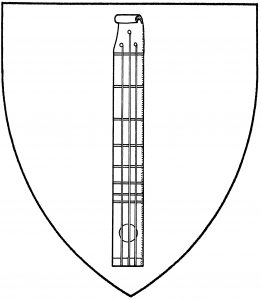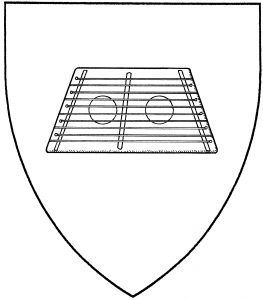One form of zither (in a sense, the generic zither) is a long slender soundbox with three or four strings; it’s found in a fresco in the church of Rynkeby, Denmark, c.1560 [Grove 27:858]. This form evolved into the Swiss “scheitholt”, described in Praetorius’ Syntagma Musica, 1619, and the more ornate “epinette des Vosges” of France, post-period – and eventually to the modern “Appalachian dulcimer”, so-called though not actually a dulcimer. The modern forms are no longer registerable, pending documentation.
The “dulcimer”, in its true sense, is a specific form of zither, a broad box with many strings. It’s a period instrument, shown in a Flemish painting Mary Queen of Heaven c.1485 [Remnant 117]. In period, the dulcimer was always played by hammering; in modern parlance, it’s best to blazon it fully as a “hammered dulcimer”.
All zithers are shown with the strings facing the viewer by default; when blazoned “proper”, they are of brown wood. No heraldic difference is granted between the various kinds of medieval zither.
Miriel d’Estoile bears: Per bend argent and azure, a compass star azure and in bend a feather argent and a fretted zither Or.
Cadwan Galwiddoe of Redmarch bears: Gules, on a bend between two mullets of eight points argent, a ram’s-headed scheitholt sable, detailed gules.
Dulcinea Margarita Teresa Velasquez de Ribera bears as a badge: A hammered dulcimer Or.

